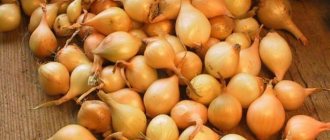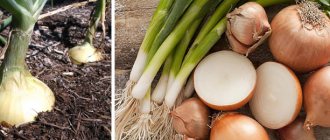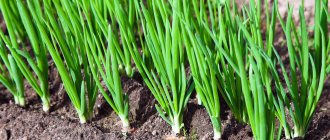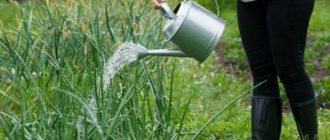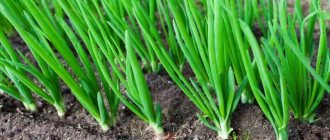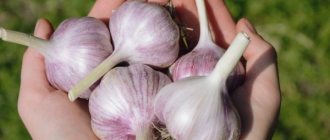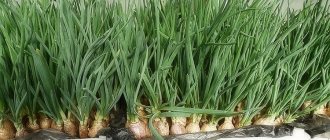To get onion greens 2-3 weeks ahead of schedule, the sets are planted before winter. Here are 15 varieties of onions that are suitable for winter planting.
If you decide to plant onions before winter, it is important to decide on the variety and choose the right planting material. Now you can buy many special winter varieties of onion sets. We tell you which of them are worth paying attention to and how to choose high-quality sets.
- How to grow a good harvest of winter onions? 10 secrets
An easy way to grow a lot of onions in your garden.
There are varieties of onions that can and should be planted before winter. There is no need to be afraid - they are not susceptible to bolting and will not freeze out over the winter.
Advantages of growing winter onions
Planting onions for the winter provides many benefits:
- early ripening;
- the sowing does not rot and is resistant to bolting;
- resistant to pests;
- you can not water until almost the beginning of summer;
- turns out very large;
- the planting material is fresh and there is no need to worry about how to preserve it until spring;
- in autumn the assortment of sets is richer and prices are lower;
- saving time in the spring, when there are plenty of other worries.
But there are also disadvantages (when compared with onions planted in spring):
- lower yield;
- the harvested crop is more difficult to store.
Planting schemes
Planting in autumn differs from spring; bulbs are placed more often and buried deeper:
- Make rows as in spring - every 20–25 cm.
- The depth of the grooves is 5–7 cm.
- Place the bulbs at a distance of 3–5 cm. Some gardeners suggest the bridge method, when the bulbs are planted in a continuous row without indentations. In spring, the seedlings are thinned out: one part is collected for greens, and the other is left to grow for turnips.
- Fill the top of the groove with humus, compost, and old sawdust. Mulch with the same materials so that the seedlings are completely covered with a 2–3 cm layer of soil.
Video: professional tips for planting onions before winter
Which onion to choose for winter sowing
Breeders have developed many varieties and hybrids of onions. But not all of them are equally suitable for planting before winter. So, southern varieties are not suitable for this at all - they need long daylight hours. Varieties that need to be planted in the spring are also not suitable: such specimens do not tolerate wintering well and, when frozen, begin to bolt.
Therefore, for pre-winter planting, choose varieties and hybrids of onions with medium or short daylight hours, which can form a bulb in a 12-14 hour day.
Another condition when choosing is good frost resistance of the variety.
Many types of winter onions are perfect for the climate of the Moscow region. There are some hybrids and varieties that are successfully grown even in the Urals.
- How to prepare beds for winter sowing: step-by-step instructions
Have you decided to try sowing vegetables and herbs before winter? No later than mid-October, prepare the beds according to the instructions!
Onions that can withstand local winters are considered suitable for winter crops. Therefore, choose zoned, rather than heat-loving southern varieties.
Here are 15 popular onion varieties among summer residents that are perfect for winter sowing.
Which onions are suitable for planting before winter
Traditionally, the following varieties are planted before winter: Stuttgarten Riesen, Strigunovsky, Bessonovsky, Danilovsky, Arzamassky; as well as modern ones specially bred for this purpose: Sunshine, Arctic, Radar. Be sure to check the State Register of Breeding Achievements to see if the selected variety is zoned for your region. It is not recommended to plant southern varieties in the middle zone and vice versa.
But deciding just on the choice of variety is not enough; you also need to pay attention to the faction of the set:
- Oatmeal are very small onions, up to 1 cm. They are sown before winter to produce turnips. A run from early spring is enough to form large bulbs from such crumbs. This faction almost never goes to war.
- Sets are heads with a diameter of 1–2 cm to 3 cm. Such onions are planted only in spring. After autumn planting, at least every second plant will shoot an arrow.
- Selections - large bulbs from 3 cm. They can be planted before winter, but on a feather. The plants produce lush bunches of greenery in early spring, but already in June, when the days are long, they shoot out arrows. You can dig up the bulbs, but they won't be of much use any further.
Onion sets come in different fractions, you need to learn to distinguish them
So, if you need onions for turnips, then we sow oats before winter, a selection for greens, and leave the sets for the spring.
Arzamas
The variety is mid-season. The taste is spicy. The bulbs are dense, round or elongated-rounded with white flesh and dark yellow outer scales with a brown tint. The period from mass germination of seedlings to lodging of leaves is 68-86 days. Productivity is 1.4-3.2 kg per 1 sq.m. The variety is cold-resistant, the bulbs store well, but are susceptible to downy mildew and attack by the onion fly.
| Use | Taste | Growing method | Bulb weight | Keeping quality |
| spicy | 40-90 | good |
Right time, right place
It is impossible to name the exact date for the start of planting onions before winter. Each region has its own deadlines. For the middle zone climate, it is optimal to start work in early to mid-October, but in each case you need to focus only on local conditions. It is clear that there is no point in planting in frozen ground, but planting too early can also bring problems - the set may “wake up” ahead of time if the weather is too warm. If this happens, the greens will freeze and the entire future harvest will die.
Planting too late will not give the bulbs the opportunity to take root; they will simply be stored in the ground until spring. As a result, you can forget about the early harvest, all the benefits of winter planting disappear. It is recommended to base your choice of time on soil temperature. When the soil maintains a stable temperature of about + 5°C, it’s time to plant winter onions.
Timely planting of onions will give a rich harvest
Checking the soil temperature is quite simple. Make a small hole (5-10 cm) and lower an ordinary external thermometer (not a medical thermometer!) into it. Repeat measurements several times throughout the day. The average measurement will be the stable soil temperature.
You should not plant a garden bed in the same place for more than two years in a row. Only in four years will it be possible to return to the previous site. Alternate crops to increase productivity. Onions take root well after grain crops, beets, tomatoes, cucumbers, and cabbage. But potatoes, parsley, and celery can “inherit” their diseases through the soil. It is convenient to plant winter onions as a “second wave” after the early varieties of radishes, carrots and beets.
Onion beds are located in an open, sunny, but protected from the wind place. Humus-sandy soil or loam is suitable. The selected area must be well drained; stagnation of moisture can lead to rotting. A weak root system will not be able to find nutrients in poor soil, so the bud must be fertile. Before work, you need to loosen the soil well and add humus (5-6 kg per square meter) and mineral fertilizers (10-15 g of potassium salt and 20-25 g of superphosphate per square meter). Just before you start planting, scatter the ash (about 10 g per square meter).
Danilovsky
Refers to mid-season varieties. It has good yield and good keeping quality. The color of the bulbs is red-violet, the shape is flat-round. They grow up to 150 g. The taste is semi-sharp, with sweet undertones. The variety is relatively resistant to mildew.
| Use | Taste | Growing method | Bulb weight | Keeping quality |
| spicy | 50-100 | good |
Hercules F1
Hercules F1 is classified as a mid-early hybrid - full-fledged large bulbs can be harvested approximately 70-80 days after germination. The height of the plant can reach 35 cm, the fruit itself is quite large - 120-160 g. Hercules F1 resists diseases well and shows high yields - up to 8 kg per 1 sq.m.
| Use | Taste | Growing method | Bulb weight | Keeping quality |
| spicy | 85-100 | good |
Nuances of care
Winter care does not involve any additional actions other than insulating the beds and creating a snow layer at temperatures below 10-15°C. This is especially true for the northern regions.
Watering mode
Do not water the onions immediately after planting . In dry weather, watering is carried out after 10 days. In the spring, when the snow melts, the ground contains a sufficient amount of moisture, so water as needed if spring and the first month of summer are hot.
Loosening the soil and weeding
During the growth process, the soil is loosened as needed , and also a day after watering; this is done carefully so as not to pull out the fruits. Weeding is carried out twice per season.
Top dressing
The first fertilizing is carried out after the emergence of seedlings in the spring . To form greenery, add a solution of 30 g of ammonium nitrate, 20 g of potassium chloride, 40 g of superphosphate, diluted in 10 liters of water. After three weeks, re-feeding is carried out, increasing the amount of superphosphate to 60 g, potassium to 30 g.
The third time, a solution consisting of 10 liters of water, 20 g of potassium, 40 g of phosphate is added.
Disease and pest control
Most often, the crop is susceptible to downy mildew . To protect the plant from disease, in the fall, before planting in the ground, the seedlings are inspected for damage by disease or insects. At the slightest sign, the fruits are treated with fungicides, following the manufacturer's instructions. Fermented milk products, iodized or soda solution are also used to fight the disease.
To avoid infection by fungi , ensure compliance with the rules of crop storage and crop rotation.
Corrado F1
Mid-season high-yielding hybrid. The bulbs are round in shape, golden yellow in color. The taste is medium-hot. Has a long shelf life. Resistant to many diseases and pests. Productivity – up to 6 kg per 1 sq.m.
| Use | Taste | Growing method | Bulb weight | Keeping quality |
| semi-sharp | 90-120 | excellent |
Radar
The variety is mid-season, characterized by a high level of productivity. The bulbs are large, flat-round with light yellow dry scales, can reach 300 g. Suitable for long-term storage. Resistant to diseases and pests, as well as bolting.
| Use | Taste | Growing method | Bulb weight | Keeping quality |
| semi-sharp | 150-300 | excellent |
How to choose an onion variety for planting
There are many varieties of onions, but how do you decide which variety is the best for planting? In fact, you can grow green onions from any type of this crop. By choosing a bulb, you can determine the number of rudiments. To do this, just cut the onion in half. Which onion variety is best? We present several varieties of onions, from which everyone can choose their favorite:
- Leek. This type of onion is sometimes also called pearl onion. The lower part of the plant is most often used for food, but the upper part is also worth trying. Leek leaves have a delicate taste. In appearance they resemble garlic, but are slightly wider. With the most minimal care, you can harvest 20 kilograms of onions from a 9 square meter garden bed.
- Onion. There are perennial and annual varieties of this onion. Sometimes it is called pipe, Tatar or sandy. This species is characterized by high productivity and has beautiful, even greenery. Greens can be cut several times during the growing season.
- Slime bow. The appearance of onions has similar features to garlic leaves. A faint garlic aroma adds to the similarity. The leaf structure is wide and flat. There are also differences. Slime has a very delicate structure. The advantages of the species include high productivity and early maturity. Onions are frost resistant. When grown in open beds, onions delight with green feathers until frost. In closed ground it produces crops all year round.
- Shallot. The most famous type of onion. It is widely used in cooking. Feathers are well stored, remaining juicy. Onions are easy to grow and do not require special care skills. It has high productivity.
- Multi-tiered onion. Canadian or Egyptian onions are considered the most unpretentious. It is resistant to low temperatures. In terms of the quality of the resulting greens and yield, other varieties cannot compete with this species. Multi-tiered onions easily remain overwintered in the ground, and the next season they grow again.
- Chives. Another name is chisel. The long and thin leaves of this onion are its main advantage. Onions have a great aroma. Can be stored for a long time, taste and structure are perfectly preserved. Good yield.
Gardeners can pay attention to other popular varieties. Among the most popular: Rostov, Black Prince, Amber onions and others.
Red Baron
The variety is early ripening. The bulbs are round, flattened at the top and bottom, red or dark purple in color outside and inside. About 3 kg of onions are harvested from 1 square meter. It has increased resistance to root rot, downy mildew, and fusarium. Keeps well for a long time.
| Use | Taste | Growing method | Bulb weight | Keeping quality |
| semi-sharp | 50-120 | good |
Senshu Yellow
The above-ground green part of the plant grows 50 cm high, the leaves-feathers are wide, rich green, juicy. The turnip is round, somewhat flattened, and under favorable conditions reaches 250 g.
It has good resistance to typical onion diseases, especially powdery mildew. Doesn't shoot.
| Use | Taste | Growing method | Bulb weight | Keeping quality |
| spicy | 160-180 | good |
Reviews of winter varieties of onion sets
When planting onion sets before winter, choose the variety with special care . Pre-winter planting is becoming increasingly popular among vegetable growers, and summer residents are happy to share their impressions of the varieties they love.
Elena, Oryol region : “I plant it in winter because I don’t have to worry about where and how to store onions for sowing. I planted it before the frosts, covered it with leaves from the garden if necessary, and in the spring I got greens and turnips.”
Grigory, Rostov region : “I’ve been planting Radar onions for several years now - the bulbs are large and ripen early. I like to grow it because it is easy to care for. There is less grass in the beds, and there is almost no need to water.”
Valentina, Perm : “Despite the fact that such onions are stored worse than spring onions, the bulbs turn out larger and denser. We plant varieties Senshui and Shakespeare. The onions are sweet, the children eat them with a bang.”
Snow globe (Snowball)
The variety is early ripening, cold-resistant, exceptionally productive. The bulbs are pure white, round, well-aligned in shape. The taste is semi-sharp. High resistance to diseases. Does not apply to keeping varieties.
| Use | Taste | Growing method | Bulb weight | Keeping quality |
| semi-sharp | 70-100 | average |
Setton
This variety was developed based on the Sturon variety. The bulbs have an elongated shape and golden color, the taste is slightly spicy. Setton is resistant to gunfire. Resistant to diseases. From 1 sq.m you can collect up to 6 kg of bulbs.
| Use | Taste | Growing method | Bulb weight | Keeping quality |
| semi-sharp | 100-200 | excellent |
Sturon
The variety is mid-season, grows and ripens within 100-110 warm days. The bulbs are round, with white flesh, covered with dense yellow-brown scales. The taste is bitter. Resistant to diseases and bolting. Productivity – up to 8 kg per 1 sq.m.
| Use | Taste | Growing method | Bulb weight | Keeping quality |
| spicy | 70-180 | good |
Main advantages and disadvantages
obvious advantages of planting winter varieties of onion sets :
- Getting excellent onions from small sowing - the smaller the turnip, the less likely it is to bolt.
- Early harvest - winter onions ripen 6-8 weeks earlier than spring onions.
- Affordable price, large selection of planting material.
- Easy to care for. The beds do not require watering until spring.
- Solving the storage issue. The resulting harvest does not rot and does not shoot arrows.
Among the shortcomings noted:
- Sudden temperature changes, high humidity, and severe frosts negatively affect the harvest.
- Winter varieties are stored worse than spring varieties.
Differences from other varieties
The main difference between winter types of onions is the size of the bulbs . Varieties planted before winter produce larger fruits with a characteristic pungent taste. Provided that the seed material is selected correctly and the requirements for planting and care are met, the harvest is harvested in mid-summer.
Turbo
Mid-season variety. From full germination to harvesting of root crops, 110-120 days pass. Bulbs with bright golden scales and white flesh. Belongs to the group of semi-sharp varieties. Resistance to diseases and pests is average. You can collect about 6.5 kg from 1 sq.m.
| Use | Taste | Growing method | Bulb weight | Keeping quality |
| semi-sharp | 120-150 | good |
Preparing the site and bulbs
First of all, you need to correctly select and prepare the site so that winter onions sprout well.
Did you know? South-West Asia is considered to be the birthplace of onions, but the exact place of origin of this crop has not yet been established.
When choosing a place to grow winter onions, you need to consider the following indicators:
- the selected area should not be in a draft, but should be ventilated;
- this crop grows well only in sunny areas;
- plants need fertile soil that has a loose structure and a neutral reaction;
- You cannot plant winter onions in a place where water accumulates in the spring - the planting material will rot;
- It is recommended to use for growing this crop an area where beets, legumes, tomatoes, cabbage or mustard previously grew;
- Poor predecessors for winter onions are potatoes, celery or parsley.
The basic rules for preparing the selected site for sowing winter onions are listed below:
- after the autumn harvest, remove all plant debris from the site - they can be a source of fungal infections or pests;
- add urea, humus or compost to the soil, and then dig up the area to a depth of about 20 cm - this procedure will enrich the soil with the necessary nutrients;
- Before planting, apply potassium and phosphorus fertilizers - they will help the planting material to take root better and survive the winter safely;
- Immediately before planting, the soil on the site must be well loosened.
Before planting winter onions, you need to prepare the set itself.
This process consists of the following stages:
- select hard bulbs with a smooth surface, without signs of damage;
- the size of the bulbs should be 2.5–4 cm - such planting material will produce a sufficient number of feathers;
- soak the selected seeds in a solution of potassium permanganate for 20–30 minutes for disinfection, and then dry at room temperature;
- To speed up the germination of bulbs, you can cut off their tops before planting.
Important! The selected planting material should be approximately the same size - this will allow for more uniform germination.
Shakespeare
The variety is mid-season. The bulbs are large. The taste is semi-sharp. It is not prone to bolting, which greatly distinguishes it from other winter varieties. Productivity is about 3.5 kg per 1 sq.m.
| Use | Taste | Growing method | Bulb weight | Keeping quality |
| semi-sharp | 150-300 | good |
Stuttgarter Riesen
An early ripening variety of universal use. The period from planting to mass lodging and yellowing of leaves is 66-73 days. The bulb is medium in size and, with good care, large. From 1 sq.m you can get about 3.5 kg. Susceptible to downy mildew and neck rot.
| Use | Taste | Growing method | Bulb weight | Keeping quality |
| spicy | 50-100 | good |
Preparation of planting material: care, processing
Before you start planting onions, you need to prepare for this process. You need to choose seeds for planting. It should be remembered that large onions are taken to obtain green sprouts, and small ones are used to obtain a medium-sized onion harvest. This event should be carried out approximately 10 days before direct planting in the ground. In the process of sorting and preparing bulbs for planting, you should not cut off their necks, otherwise the onions will fall into feathers. As a rule, in the spring planting is carried out on the head, i.e. for subsequent planting material - seedlings.
Disinfection of seedlings
Having selected the appropriate material, it is necessary to carry out a disinfection procedure. The bulbs are immersed in a weak solution of potassium permanganate for at least 6 hours. In addition to potassium permanganate, you can use a saline solution. To prepare it, add a tablespoon of salt to a liter of water. In this case, the bulbs are immersed in the solution for 3 hours. Then for the next 3 hours the solution is replaced with manganese. Afterwards the bulbs are dried. Drying takes up to one week. To ensure even drying, turn the bulbs over. Then the quality of the bulbs is checked. They must be intact, without rot.
Dried bulbs with damaged areas should not be used for planting.
Early sowing or nigella
The seeds of the plant are black, which determines their name - nigella. How to grow onion seeds is described in this material. The seeds produce early shoots, which are characterized by greater endurance compared to plants sown in spring. It should be noted that the seeds of a productive crop do not always have time to produce a good harvest in one season. It is recommended to collect the seedlings in the spring, and then plant the greens in the ground before winter. In this case, you can be confident in the quality of the planting material used and expect a large harvest next season, subject to proper storage and planting conditions. To prepare seeds for planting, they are divided into fractions of different sizes. Therefore, it is best to choose perennial varieties.
Sizing: Select the correct size for fit
Winter onion heads
Bulbs should be sorted by size before planting . Planting material is divided into large, medium and small. Small bulbs, the diameter of which reaches 1 cm, are called wild oats. Medium bulbs are a set, its diameter does not exceed 3 cm. Bulbs whose diameter exceeds 3 cm are considered large and are called a selection. It is worth noting that the selection is used for planting in the spring. When planted before winter, the bulbs will begin to bloom in advance, and will freeze in winter. Calibration is carried out in order to improve the quality indicators of the crop and uniform planting of planting material on the site. Bulbs of different diameters must be planted separately. This approach ensures simultaneous germination and equal development of plants. This will bring a good harvest in the future.
Seeds for greens
Calibration is also necessary for plant seeds. Like bulbs, seeds are divided into large, medium and small. To do this, use a sieve with cells of different sizes. If you don't have a sieve, you can use water. After an hour, some of the seeds will settle to the bottom - this will be one of the fractions for planting. The remaining seeds on the surface must again be placed in water for an hour, and a second fraction for planting will be obtained. After this, only debris and seeds that cannot be planted will remain on the surface. How to plant onions in a greenhouse on a feather is described in this article.
Using a grid with a 1.5 by 1.5 cm cage, the sets are calibrated
The need to sow seeds in separate fractions is due to the timing of their germination, which may differ by one or even several weeks. This fact will negatively affect the subsequent quality of the crop.
Stuttgarter-Stanfield F1
Mid-season hybrid of Dutch selection. The color of the bulbs is golden brown. After ripening, the head becomes rounded and flattened. The taste is medium hot. It has an advantage when grown for greens, because forms three shoots at once. Resistant to onion pathogens.
| Use | Taste | Growing method | Bulb weight | Keeping quality |
| spicy | 85-150 | good |


